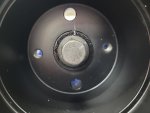Dunk67
Member
I am rebuilding a 4.0 OHV out of a '94 Ranger to swap into a Bronco II. Trying to install the balancer/damper on the crank and it does not want to fully seat. I initially installed the timing cover, lightly seated the bolts, and installed the dampener to center the seal, then tightened the dampener with a 1/2" drive ratchet pretty snug expecting final torque to be over 100 ft/lbs.
Once it was tight but the balancer was not yet pulled tight to the cam gear on the crank. I checked the book for torque spec, which calls for 30-37 ft/lbs + 90*... Which is to say a TTY bolt, so I need a new bolt. The old bolt is torqued to well above 37 ft/lbs and the balancer is pretty far front the cam gear on the crank. I'm doubtful that 37 ft/lbs+90* will get the balancer snug to the cam drive gear on the crank. Balancer is aftermarket Grayworks 102028. I have not tried to install the original balancer, which has dried and cracked rubber.
Is this crank damper bolt a TTY bolt I need to replace? What do I do if the balancer, aftermarket or original, doesn't seat against the cam drive gear at 37 ft/lbs+90*? This is the early style cam drive gear taht needs to be fully sealed against the crank for the tank to seat and ensure it doesn't come loose..
Once it was tight but the balancer was not yet pulled tight to the cam gear on the crank. I checked the book for torque spec, which calls for 30-37 ft/lbs + 90*... Which is to say a TTY bolt, so I need a new bolt. The old bolt is torqued to well above 37 ft/lbs and the balancer is pretty far front the cam gear on the crank. I'm doubtful that 37 ft/lbs+90* will get the balancer snug to the cam drive gear on the crank. Balancer is aftermarket Grayworks 102028. I have not tried to install the original balancer, which has dried and cracked rubber.
Is this crank damper bolt a TTY bolt I need to replace? What do I do if the balancer, aftermarket or original, doesn't seat against the cam drive gear at 37 ft/lbs+90*? This is the early style cam drive gear taht needs to be fully sealed against the crank for the tank to seat and ensure it doesn't come loose..













